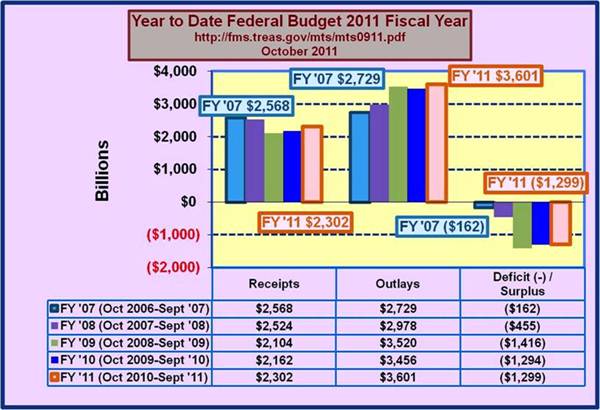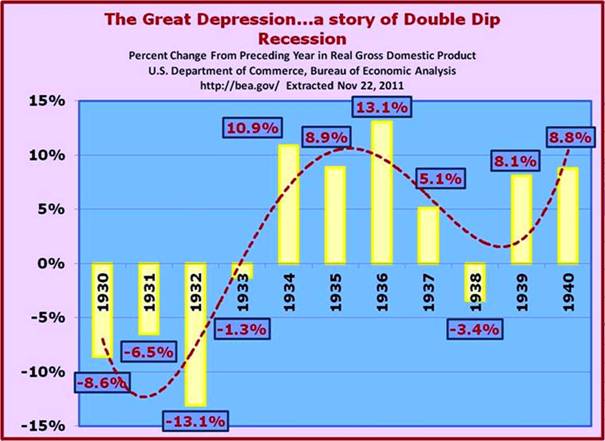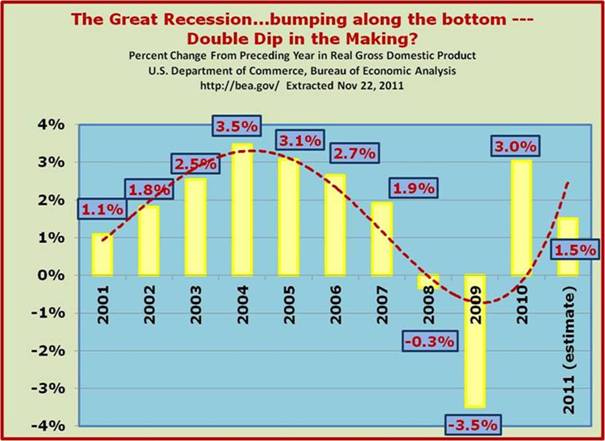***volume
December 10, 2011
For a downloadable version, click the following:
Sad Words Spoken
An examination of the failed financial and economic policies of the last few years: Part I of a three part series; a history lesson from the Great Depression and its similarity to the (current?) Great Recession
"Those who cannot remember the past are condemned to repeat it."
George Santayana
A few weeks ago the U.S. Department of Treasury released its latest estimate of the budgetary deficit for the fiscal year ending Oct. 31, 2011.
U.S. Department of the Treasury – Financial Management Service
www.fms.treas.gov/mts/mts1011.pdf

Once again it revealed an extremely large deficit of which the majority of members of the European Union, now flailing like a beached whale, would be very proud. Was it budget-breaking? No, since we have had no budget for more than two years even though there was an overwhelming majority of members in both houses of Congress of the same political party as are currently in the White house. No they are definitely not Tea Partiers.
Jim's Weekly Column
sensenbrenner.house.gov/News/Document
Washington, Nov 18
"The Democratic - controlled Senate has not passed a budget in more than 900 days."
Congressman Jim Sensenbrenner – Wisconsin, 5th District
No doubt tax revenues have suffered from the Great Recession. The problem is that the policies undertaken are a major cause for the continuing economic and financial malaise in which we are mired, chin deep, I might add. The tax base has not appreciable grown and hence the lagging tax revenues for not only the federal government but a large majority of state and local governments as well.

All of this despite the history making bail outs from Troubled Asset Relief Program – Federal Reserve site (TARP) en.wikipedia.org/wiki/Troubled, and equally futile and outright dangerous Quantitative Easings (QE1, 2, and 3). With the European Union apparently slipping back into recession, if indeed if they like us, the recession in terms of unemployment has never ended, can QE 4 be far behind?
Unfortunately, these policy failures, dating from August 31, 2008 through November 30, 2011 have added $5,442,696,898,447 to our national debt.
The Daily History of the Debt Results
U.S. Department of the Treasury, Bureau of the Public Debt
These policies have driven up debt as a percentage of Gross Domestic Product from 66% to 100%. Just as has the European Union, so highly admired by el Presidente of the U.S., gone to the brink of financial bankruptcy, the U.S. is moving rapidly toward a similar position as we squander the remaining elbow room left as sovereign risk looms larger. On what has the federal government been spending like a drunken sailor? What peculiar forms of monetary stimulus has the FED been injecting into the arteries of the U.S. financial system and how much will it cost the citizenry as a result.

We here at the New Paradigm Associates implore you to read or if you have already done so, re-read the testimony of Henry Morgenthau, the Secretary of the Treasury and confidant of Franklin Delano Roosevelt (FDR) as well as several commentaries we have cited on this topic. Again, recalling the words of George Santayana, "Those who cannot remember the past are condemned to repeat it." There is a strong similarity to the Obama policies and those of FDR.
The Great Myth that FDR saved the nation from collapse, falls apart when the numbers are looked at closely. That his policies were starkly different tan Herbert Hoover, his predecessor as president of the U.S. of A. also does not stand the test of serious scrutiny. Besides the testimony of Morgenthau before Congress in 1939, you should read or re-read the more recent studies of the failed policies of the 1930's confirming the testimony of Henry Morgenthau.
Henry Morgenthau Jr. — close friend, lunch companion, loyal secretary of the Treasury to President Franklin D. Roosevelt
We have tried spending money. We are spending more than we have ever spent before and it does not work.
I say after eight years of this Administration we have just as much unemployment as when we started. … And an enormous debt to boot!
The date: May 9, 1939. The setting: Morgenthau's appearance in Washington before less influential Democrats on the House Ways and Means Committee.
www.econlib.org/library/Enc/GreatDepression.html
Great Depression
by Gene Smiley
It is commonly argued that World War II provided the stimulus that brought the American economy out of the Great Depression. The number of unemployed workers declined by 7,050,000 between 1940 and 1943, but the number in military service rose by 8,590,000.
The Editor of this newsletter had an older brother who went from civilian federal government employee as a member of the Civilian Conservation Corps or CCC as it was called directly into the Second Marine Division without ever being employed in the private sector in between!.
Regime Uncertainty
Why the Great Depression Lasted So Long and Why Prosperity Resumed after the War
www.independent.org/pdf/tir/tir_01_4_higgs.pdf
Despite the encroachments of taxation, regulation, and other government action at all levels that had been occurring for half a century or more (Hughes 1991, 92–135; Higgs 1987, 77–167; Keller 1990), as late as 1932 business people in general and investors in particular remained—certainly in retrospect—relatively free of major threats to the prevailing regime of private property rights.
Then, during the next two presidential terms, the Roosevelt administration proposed and Congress enacted an unparalleled outpouring of laws that significantly attenuated private property rights (Leuchtenburg 1963; Badger 1989). State legislatures followed suit with their "little New Deals" (Leuchtenburg 1963, 198–88; Badger 1989, 283–84) and relentless tax increases (Brownlee 1996, 83, 85). Table 1 lists only some of the more important federal enactments diminishing or threatening private property rights. As financial economist Benjamin Anderson ([1949] 1979), an astute contemporary observer, remarked, "The impact of these multitudinous measures—industrial, agricultural, financial, monetary, and other—upon a bewildered industrial and financial community was extraordinarily heavy" (357).
Anderson was hardly the only contemporary economist convinced that the New Deal measures caused the Great Duration. [Joseph] Schumpeter, one of the world's leading authorities on business cycles, wrote in the first edition of his Capitalism, Socialism and Democracy, published in 1942.
Are we currently on the same path? Remember the economy collapsed in 1937 after a few years of growth in GNP but very little reduction in unemployment. In fact the only major reduction in unemployment during the Great Depression was first due to the nearly doubling of civilian employees on the federal payroll and then the draft and military buildup of more than 8 million in the military as WWII began.
Since this is the first in a series of articles, we conclude with some figures on, first the Great Depression, and then on the current (????) Great Recession (officiallly, it ended in June 2009 by a vote of the NBER - National Bureau of Economic Research - a learned and trusted group of academics).
Note the similarity. You would be wise to heed the warning of Santayana!!!






